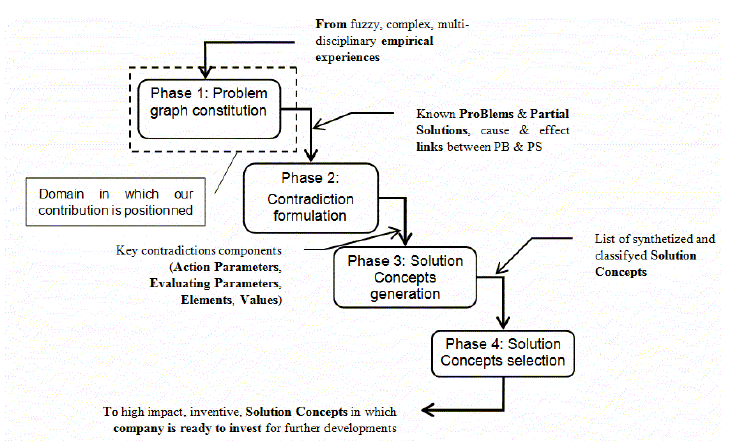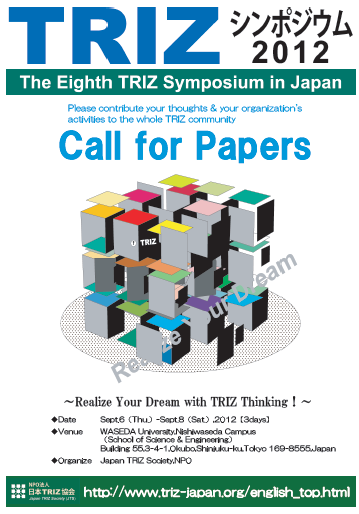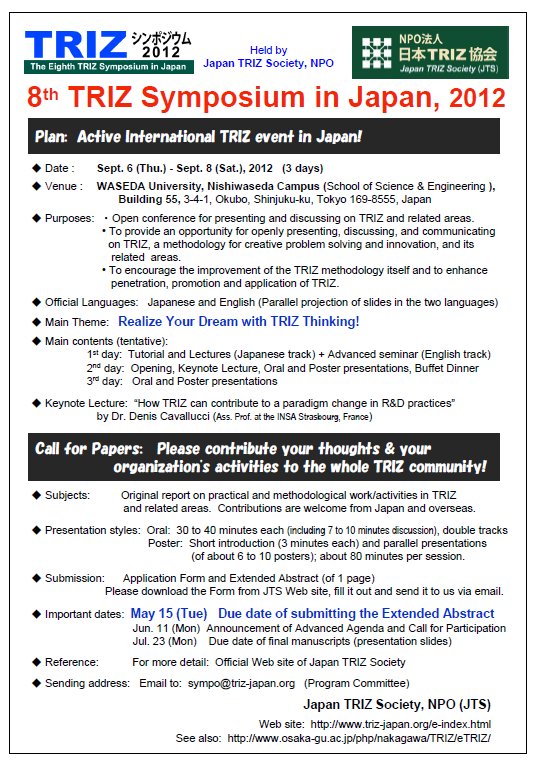| Japan TRIZ Society's Page (in "TRIZ Home Page in Japan") |



 
|
The Eighth TRIZ Symposium in Japan, 2012
To Be Held by Japan TRIZ Society, NPO,
on Sept. 6-8, 2012, in Tokyo |
Detail Page A: Abstracts of Invited Talks and Seminars, Poster for CFP |
Editor: Toru Nakagawa (Osaka Gakuin Univ.)
Note: This page is operated to support and complement the Official Web site of Japan TRIZ Society, especially in English.
=> http://www.triz-japan.org/english_top.html
|
Posted on June 11; Jul. 3; Aug. 1; Aug. 31, 2012 |
For going back to Japanese pages, press  buttons.
buttons.
 Keynote Lecture and Special Invited Lecture: Abstracts by the Authors
Keynote Lecture and Special Invited Lecture: Abstracts by the Authors
 Keynote Lecture: EI01- Cavallucci (France)
Keynote Lecture: EI01- Cavallucci (France)
How TRIZ can contribute to a paradigm change in R&D practices?
Denis Cavallucci (INSA Strasbourg, France)
Tools and methods developed during the era of quality and optimization have shown their limitations and become inappropriate in the context of the requirements of innovation. Nowadays the need to rebuild design practices in enterprises is strongly felt both in terms of human skills and methodological expertise. In part, a way to face the innovation era’s difficulties has been provided through the theory of inventive problem solving. But as TRIZ becomes more popular both in academia and industry, difficulties to obtain the best out of it is strongly felt whether we use its simplified versions or its computerized one. This keynote addresses this difficulty in presenting an original and complete framework, using industrial examples, that integrate most of TRIZ fundamentals in a methodology namely Inventive Design Method (IDM).
 Special Invited Lecture: JI04- Yumino (Japan Creativity Society)
Special Invited Lecture: JI04- Yumino (Japan Creativity Society)
Educating Creativity: Making the foundation for disseminating creation techniques
Kenichi YUMINO
(President of Japan Creativity Society; Emeritus Professor of Shizuoka University)
The question of “What”, “Why” and “How” are closely related to the emergence and progress of the study, science and technology. For these questions, Japanese schools and society that put value on “Manabi: Learning” give priority to the "How" question. However, there is “Tsukuri: Creation” together with Manabi, in the education of the "West European countries" which has firstly initiated the study, science and technology. Tsukuri includes something original for the person, not others' imitation, and involves what and why question.
When we think Tsukuri as making the foundation for disseminating creation techniques, it will be necessary to set up the special "view points" which are not included in the traditional culture or education in Japan. These are: a)not only conjecturing the opinion of a author but also requiring a learner's logic and opinion, b)praising a challenge, c) praising creative behaviors, d)praising "originality” and "uniqueness", e) evaluating not only correct answer but also the process of thinking, and f)encouraging debate and discussion based on data and the fact, etc.
If a child grows up with a custom to consider an ambiguous problem by praising from above view points, and mastered creation techniques, such as TRIZ, it might be expected that the higher quality of ideas will be obtained. In this small lecture, I'd like to introduce examples about "Manabi" and "Tsukuri", "Intelligence" and "Creativity", "Western education" and "Japan's education", "the way of praising that develops Intelligence and Creativity", and add comments about these.
[Editor's Note (T. N., Jul. 3, 2012): Prof. Yumino's short talk in a discussion has been posted in "TRIZ Home Page in Japan"  (Jul. 3, 2012)
(Jul. 3, 2012) ]
]
 Special Invited Talk: EI03- Shin (Korea)
Special Invited Talk: EI03- Shin (Korea)
How to learn TRIZ with ease and fun
Jeongho Shin (eTRIZ, Korea)
As TRIZ is undoubtedly one of the most popular methodologies for systematic problem solving, it is now widely used to improve products, services, and systems. However, most of the people who learn TRIZ for the first time think that TRIZ is very difficult and assume that it takes much time to go to the level of applying TRIZ. In order to invite them to the TRIZ world, there should be a measure to help them. This paper introduces three approaches that help learn TRIZ with ease and fun. Firstly, the SCM (Simple Contradiction Modeling) has been developed for easy modeling of contradictions using a diagram that consists of 5 components. A user can easily describe contradictions and explain to others with the help of the visual diagram. Secondly, the Invention Song helps memorize invention principles. Each line of the song stands for one of 8 invention principles selected from 40. Lastly, the Invention Card can be used for playing as well as brainstorming. Using this card, a user can easily check all the invention principles and those typical examples and apply to generate ideas like playing. It is illustrated that easy and funny approaches can be utilized as good instruments for training TRIZ beginners.
==> Japanese version has been prepared by Toru Nakagawa and is shown in the Japanese page  (Aug. 1, 2012)
(Aug. 1, 2012)  [This has been delete on Aug. 31, 2012]
[This has been delete on Aug. 31, 2012]
Note (Aug. 31, 2012 Toru Nakagawa) In this place a table of new words of the Invention song (in English and in Korean) was shon since Aug. 1, but it has been deleted today on the reasons shown in the parent page.
 Seminar (A) in Japanese on the First Day (Sept. 6, 2012 (Thu.)): Abstracts by the Authors
Seminar (A) in Japanese on the First Day (Sept. 6, 2012 (Thu.)): Abstracts by the Authors
 Tutorial: JI05-Kasai (IDEA)
Tutorial: JI05-Kasai (IDEA)
Basics and Usage of TRIZ
Hajime Kasai (IDEA Co.)
 Special Interest Lecture (a): JI06-Kurosawa
Special Interest Lecture (a): JI06-Kurosawa
“Physical Contradiction” - A study
KUROSAWA, Shinsuke
“Physical Contradiction” is one of the key concepts of TRIZ, the problem solving method. It is a good idea to review this important concept together with the audience of the Japan TRIZ Symposium. Following issues are planned to be discussed:
Placing of the Physical Contradiction in the system of Theory of Inventive Problem Solving
How was the concept born?
How is the concept treated in the contemporary world TRIZ community?
How to use Physical Contradiction as a TRIZ tool
 Special Interest Lecture (b): JI07-Kikuchi
Special Interest Lecture (b): JI07-Kikuchi
Introduction of cases using TRIZ in corporations
Fumiko Kikuchi (Pioneer Corporation), Coordinator: Setsuo Arita (Hitachi, Ltd.)
On the whole, staffs in a corporation who are employing TRIZ (regardless of the way of applying) for solving problems belong to R&D section, developing/designing section or HRD (Human Resource Development) section. On the contrary, a person who would like to introduce TRIZ into his (her) company points out the existence of obstacles even though he (she) considers that TRIZ is powerful and useful. This presentation has some actual cases which were already released in past symposiums and some consideration from some points of view. It is helpful for people who would like to introduce TRIZ into their companies or would like to know TRIZ more.
 Special Interest Lecture (c1): JI08-Nakagawa
Special Interest Lecture (c1): JI08-Nakagawa
How Can We Proliferate TRIZ among Younger People? -- Education and Training Experiences of Problem Solving with TRIZ
Coordinator: Toru Nakagawa (Osaka Gakuin University)
We, Japan TRIZ Society, recognize the importance of proliferating TRIZ to younger people much better and wider. There can be several different approaches: (a) to challenge the atmosphere of the current era for younger people, (b) to present TRIZ in the form acceptable to the background of the younger people, (c) to make TRIZ easier to understand/accept, (d) to let them practice rather than to let them learn the knowledge, (e) to expand the applicable areas of TRIZ, etc. In the present Symposium, various authors are presenting and discussing their own works in these different approaches. In the present session of Special Interest Talks, we are going to have a few short presentations of case studies of TRIZ education/training at universities, graduate schools, and industries (especially for fresh employees). We would like to put stress on the approaches with exercises and practices of real problem solving rather than those of teaching/lecturing the knowledge of TRIZ methods.
 Special Interest Lecture (c2): JI09-Ikeda
Special Interest Lecture (c2): JI09-Ikeda
Report of Lecture Series on Invention at a Graduate School: Aimed for Revival of Japan as a Nation of Outstanding Technology
Akihiko Ikeda (Kanagawa Institute of Technology and Sony) and Masao Ishihama (Kanagawa Institute of Technology)
How can we improve our inventive mind and skill? When is the best time to start learning invention? The author has been continuously asking these questions to himself since he came across TRIZ for the first time. If we can answer to these questions, then revival of Japan as a nation of outstanding technological power will follow. Further, contribution to the world wide social development will be made by solving problems across country borders through invention. As the first step to answer to the questions above, a lecture series titled “Creative Problem Solving” was conducted at a graduate school of Kanagawa Institute of Technology in the year of 2010.
How can we educate students who don’t have any work experience in industry? To meet this challenge, an in-company training program that the author had created was implemented with some modification. In this modification, the author exploited his own experiences of consulting research and development in industry. The author’s first and most important idea for effective teaching was to let the students enjoy invention. This naturally led the students realizing the importance of creativity. In this report, such items as activities to encourage students move from learning theory to applying it, the students’ impression on this lectures and the teacher’s impression are described.
 Seminar (B) in English on the First Day (Sept. 6, 2012 (Thu.)): Abstract by the Author
Seminar (B) in English on the First Day (Sept. 6, 2012 (Thu.)): Abstract by the Author
Advanced Seminar: EI02- Cavallucci (France)
From TRIZ to Inventive Design Method (IDM): towards a formalization of Inventive Practices in R&D Departments
Denis Cavallucci (INSA Strasbourg, France)
Abstract
In today’s methodological world, TRIZ has undoubtedly its place in the myriad of methods and tools useful for engineers in companies. Mostly dedicated for solving inventive problems, TRIZ is appreciated for its capacity to widen the scope of possible domains in which the solution is sought after. In that regards, it is often perceived by companies as a potential replacer of creativity techniques such as Brainstorming. We disagree with this statement in presenting TRIZ as, firstly, a theoretical framework for inventive thinking, second, as any theory, it aims to serve as a framework for developing new methods and tools useful in a certain context. Inventive Design Method (IDM) has been developed to re-structure and complete TRIZ body of knowledge with other theories like graph theory or Pugh’s theory. The objective is to integrate companies’ set of methods to pragmatically serve an innovation strategy with engineering tools open to invention. This advanced seminar is provided to describe, with concrete exercises, the main stages of IDM.
Extended Abstract
Our industry is currently undergoing a transformation that is guiding it from the quality era to that of innovation. This transformation necessarily involves changing design practices, the foundations of which currently rest on an optimization mentality. An innovation oriented approach would require that the bases of the design action contain other rules of invention where creativity and problem solving would have priority.
The methodology we discuss in this advanced tutorial (namely Inventive Design Method) is the result of 10 years of research at INSA Strasbourg (from [1] to [8]). It concerns the mapping of known information and the transformation of these pieces of information into a model that will facilitate a later problem solving stage.
IDM framework proposes four main phases to evolve from a fuzzy and multidisciplinary initial situation to a set of ranked inventive solution concepts. Here is a short description of theses phases:
Phase 1: Initial Situation Analysis: As stated in the introduction, this phase aims at investigating all the knowledge related to the study. This knowledge (tacit or explicit, coming from text documents of from experts’ minds) is translated into a graphical model, mathematically exploitable, to facilitate decision-making.
Phase 2: Problems Mapping: Once the complete initial situation has been stated, a reduced set of problems must then be detailed by a set of contradictions. These contradictions represent bottlenecks in the evolution of the studied system. In this phase, we find sub-steps such as, poly-contradictions formulation, contradictions extraction and classification of the importance of contradictions in accordance with a specific scenario.
Phase 3: Solutions Concepts Synthesis: Each contradiction declared as a priority for the solving phase becomes an input point for the use of the different TRIZ techniques and tools. Each contradiction must be engaged in a solving process to be resolved without compromises. At the end of multiple solving stages, which can be successive or iterative, we can include the use of Altshuller’s matrix associated with inventive principles, Substance-Field modelling associated with the system of Inventive Standards or even ARIZ-85C. Expectations regarding this phase are the generation of a limited number of solution concepts and the possibility of tracking their origin for the follow-up of the study.
Phase 4: Feedback between Solution Concepts and the Initial Situation: in this phase, we measure the impact of each solution concept with the problem graph elaborated in phase 1. This stage is built to estimate the hypothetical impact of each Solution Concept and choose that will be the subject of future developments.
A macro-representation of this process so as the information flow along the four phases is given figure 1.

Figure 1: Macro representation of the four stages of Inventive Design Method
The session is divided as follows :
10:00-11:00: Introduction of the advanced tutorial, aims and scope, methodology and personal introduction. Brief description of paradigm shift in industrial era (from quality to innovation) and the necessity to address the challenge of designing in the era of innovation with new methods and tools.
11:00-12:00: From TRIZ to Inventive Design Methodology: TRIZ limitations, our proposal to overcome these limitations through a structured approach. Brief description of IDM’s main stages.
Lunch break
13:00-14:00: Problem Graph construction and its derivation into Parameters.
14:00-15:00: From problem graph interpretation to a set of ranked contradictions.
Coffee break
15:30-16:30: Solving highly ranked contradictions in priority using TRIZ techniques and generating Solution Concepts. Then, using the ranked solution concepts to build an appropriate R&D strategy.
References:
[1]Rousselot F., Zanni C. and Cavallucci D. (2012) Towards a Formal Definition of Contradiction in Inventive Design, Computers in Industry, volume 63 (2012), pp. 231-242, ISSN: 0166-3615, ELSEVIER.
[2]Zanni C., Cavallucci D. and Rousselot F. (2011) Use of formal ontologies as a foundation for inventive design studies, Computers in Industry, Volume 62, Issue 3, Pages 323-336 ISSN: 0166-3615, ELSEVIER.
[3]Cavallucci D., Rousselot F. and Zanni C., (2010); Initial situation analysis through problem graph, CIRP Journal of Manufacturing Science and Technology, Volume 2, Issue 4, 2010, Pages 310-317, ISSN: 1570-5838, ELSEVIER.
[4]Cavallucci D., Rousselot F., Zanni C.; (2009); Linking Contradictions and Laws of Engineering System Evolution within the TRIZ Framework, Creativity and Innovation Management, Volume 18, Issue 2, June 2009, ISSN: 0963-1690,Wiley-Blackwell, Pages: 71-80.
[5]Cavallucci, D. and Khomenko, N. (2007); From TRIZ to OTSM-TRIZ: Addressing complexity challenges in inventive design; International Journal of Product Development (IJPD), Inderscience, Volume 4 - Issue 1/2 – 2007, ISSN: 1477-9056.
[6]Cavallucci, D., Weil R., (2001). "Integrating Altshuller's development laws for technical systems into the design process. Cirp Annals-Manufacturing Technology 50(1): 115-120, ELSEVIER.).
[7]Cavallucci D., Rousselot F. and Zanni C., (2009) Monitoring the impact of solution concepts within a given problematic, 3rd IFIP Working Conference, August 21-23 2009, Harbin, China.
[8] Cavallucci D., Rousselot F. and Zanni C., On contradiction clouds, 8th ETRIA’s International TRIZ Future Conference (TFC2008), Nov. 5-7, Twente – The Netherland.
[Note: Dr. Cavallucci kindly allows us to post his Extended Abstract before the Seminar, for the sake of prior study by possible attendees.]
[Note: Participants are advised to bring in their own PC after downloading the demo version of the software tool STEPS. Instruction will be announced late August. (Aug. 1, 2012)] [The Instruction was sent to the Seminar (B) Participants via email on Aug. 31. (Aug. 31, 2012)]
[The Instruction was sent to the Seminar (B) Participants via email on Aug. 31. (Aug. 31, 2012)]
 Group Discussions: (A)(B)(C) Joint Meeting on the First Day Evening
Group Discussions: (A)(B)(C) Joint Meeting on the First Day Evening
On the First Day evening, 18:00 - 20:00, Sept. 6, 2012 (Thu.), we are going to have Group Discussions as a Joint Session of (A)(B) and (C). Forming several groups of common interests, we are going to have supper together and discuss frankly (at the Cafeteria of Bldg. 63). Topics of groups will be announced later. ==> See below (Aug. 31, 2012)
Group 1: "Further Extension of TRIZ and its Applications in Industries",
(in English, with interpreter support from Japanese to English)
Coordinators: Manabu Sawaguchi, Yoshihisa Konishi, and (Prof. Denis Cavallucci):
"We want to consider the posibility of fiurtehr extension of TRIZ in industries through free discussion regarding development of TRIZ methodology, organizing a variety of opinions from participants not only in Japan but also in foreign countries."
Group 2: "Introduction, Application, and Proliferation of TRIZ in Industries",
(in Japanese only)
Coordinators: Mamoru Zenko, Shusei Kunitomo, Takeshi Ogata.
Free discussion in Japanese on the topic.
Group 3: "How to Proliferate and Teach TRIZ to Younger People",
(first 60 minutes in English during, and later 30 minutes in two separape groups one in English the other in Japanese.)
Coordinators: Toru Nakagawa, Maso Ishihama, Akihioko Ikeda; (Prof. SeungHyun Yoo)
"What should we do to convey TRIZ (or more widely the 'Creative thinking
for problem solving') to younger people (such as businessmen/engineers
of up to 2-3 years of experiences, university students, high- and middle
school people, and children). This theme is one of the main pillars of
topics in the present Symposium.
First we wouldlike to learn Dr. Shin' approach and try to sing the Invention Song together as a rehearsal. Some relevant presentations from overseas (e.g. Prof. Yoo) and from Japan will be introduced briefly, to clirify ther intentions. During the last 30 minutes, free discussions are expected."
 Poster and Flyer
Poster and Flyer
 Poster (for Call for Papers)
Poster (for Call for Papers)

Download Poster for printing  (PDF 851 KB)
(PDF 851 KB)
The center illustration was designed by Mr. Kazuo Gotoh with the motive of 'nine windows'.
"How can you find a box containing your dream? and How can you open it?"
Please download the Poster for printing and print it in the size of A3 or A4.]
 Flyer (for Call for Papers)
Flyer (for Call for Papers)

Download Flyer for printing  (PDF 65 KB)
(PDF 65 KB)
 Additional Call for Papers (Jun. 4, 2012) ==> PDF
Additional Call for Papers (Jun. 4, 2012) ==> PDF 
Our Symposium has already accepted 9 invited presentations (including 3 from overseas) and 33 contributed ones (including 8 from overseas) and is going to announce its Advance Agenda on Jun. 11. However, we call for additional contributed presentations in a limited number until Jun. 30, mainly for the purpose of accepting delayed applications from overseas and ones from the members of our new sponsor, Japan Creativity Society (JCS). If you are interested in application, please contact me immediately at sympo@triz-japan.org .
Additional Call for Presentations:
First contact showing your intention:immediately, no later than Jun. 20, 2012
Application form (Form A) and Extended Abstract (Form B): due date Jun. 30, 2012
Notice of acceptance:from Jun. 20 to Jul. 2, 2012
Final manuscript (slides: required, full paper: optional): due date Jul. 23, 2012
Contact: Email to Toru Nakagawa at sympo@triz-japan.org
Last updated on Aug.31, 2012. Access point: Editor: nakagawa@ogu.ac.jp




